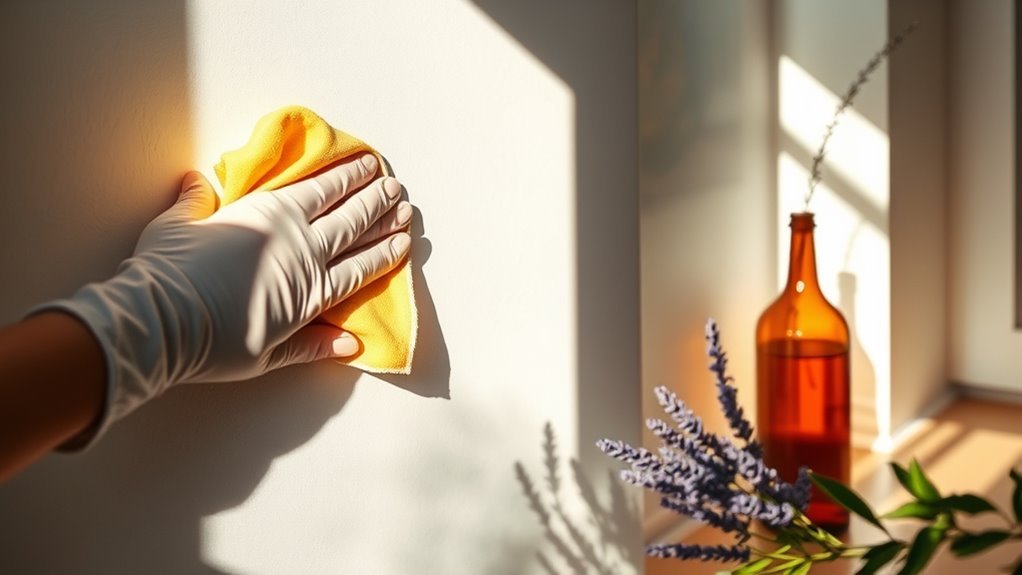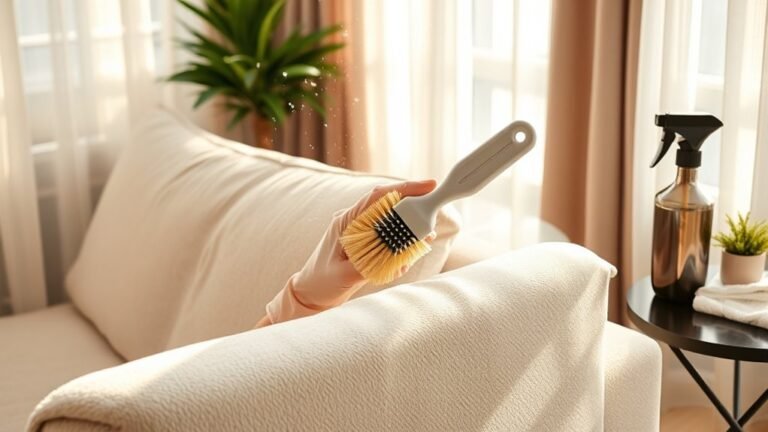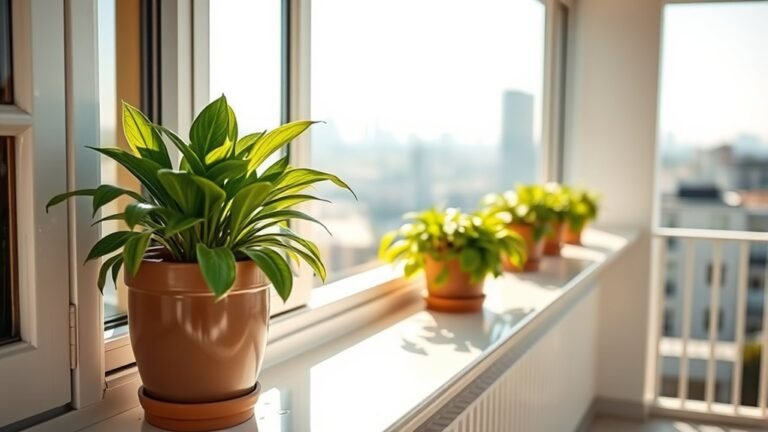Using Essential Oils to Clean Walls
You can clean your walls naturally using essential oils like lemon, tea tree, and lavender, which kill germs and leave a fresh scent without harsh chemicals. Choose oils based on your wall type—citrus for painted walls and herbal for delicate surfaces. Mix oils with water or vinegar, then apply gently with a soft cloth. Start with a small test spot to avoid damage. Keep walls fresh between deep cleans for a vibrant, healthy home. There’s plenty more to explore on using these oils effectively.
Benefits of Using Essential Oils for Wall Cleaning
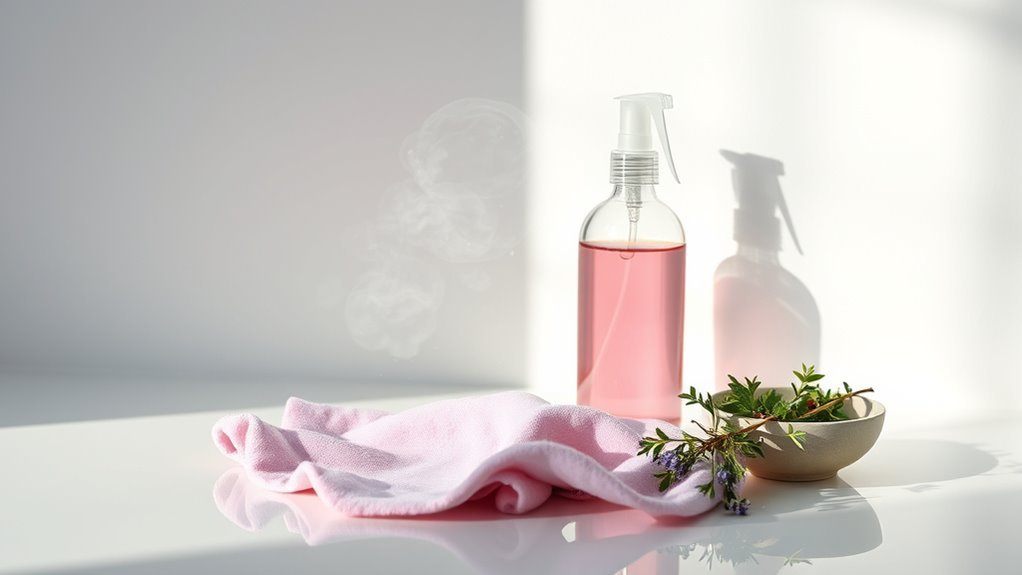
There are several clear benefits to using essential oils for wall cleaning that you might not have considered. When you choose essential oils, you’re embracing freedom from harsh chemicals and synthetic fragrances. Their aromatic properties not only leave your space smelling fresh but also create a calming atmosphere, enhancing your environment naturally. Essential oils act as natural disinfectants, effectively eliminating germs without compromising your health or the environment. This means you can clean with confidence, knowing you’re protecting yourself and your loved ones. Plus, using essential oils allows you to customize the scent and strength of your cleaning solution, giving you total control over your home’s ambiance. By switching to essential oils, you’re choosing a cleaner, safer, and more liberating approach to wall care.
Choosing the Right Essential Oils for Different Wall Types
When choosing essential oils for cleaning your walls, it’s important to match the oil type to your wall surface to avoid damage. You’ll also want to take into account the aroma each oil brings, as some scents work better in certain rooms. Plus, selecting oils that are safe for painted walls will keep your finish looking fresh without any harm.
Oil Types for Surfaces
Choosing the right essential oils for your walls depends largely on the surface material you’re dealing with. Different surfaces respond better to specific oils—citrus oils work wonders on hard, washable walls, while herbal oils are gentler for textured or delicate surfaces. Here’s a quick guide to help you pick the best oil for your wall type:
| Surface Type | Recommended Oil | Benefit |
|---|---|---|
| Painted Walls | Citrus Oils | Cuts grease, fresh scent |
| Wallpaper | Herbal Oils | Gentle, non-damaging |
| Wood Panels | Citrus Oils | Cleans and shines |
| Textured Walls | Herbal Oils | Preserves texture |
Aromatic Benefits by Wall
Aromas can transform your cleaning routine into a invigorating experience tailored to each wall type. When choosing essential oils, consider how they complement the material and the vibe you want to create. For smooth surfaces like painted drywall, citrus oils like lemon or orange offer a fresh, clean aromatic ambiance that uplifts the space. Wood walls benefit from warm, grounding scents like cedarwood or sandalwood, enhancing the natural texture with subtle scent therapy. Textured or wallpapered walls pair well with floral oils such as lavender or geranium, adding softness and calm without overpowering. By selecting oils that harmonize with your walls’ character, you turn cleaning into a moment of freedom and sensory delight, making every room feel uniquely rejuvenating and alive.
Safe Oils for Paint
Since essential oils vary in their chemical composition, not all are safe for painted walls. You want to pick oils that respect paint compatibility to avoid damage or discoloration. Citrus oils like lemon or orange, while great for cleaning, can be too harsh for delicate finishes. Instead, opt for gentle safe oil combinations such as lavender and tea tree; they’re effective yet mild. When mixing your cleaning solution, always test a small, hidden area first to verify no adverse effects. Water-based paints generally tolerate mild oils better, while oil-based paints need extra caution. By choosing the right oils, you maintain your walls’ look and enjoy the freedom of a natural, fresh-smelling home without worry. Safe oil choices empower you to clean confidently and protect your space.
Preparing Your Walls Before Cleaning
Before you start cleaning your walls with essential oils, you’ll want to clear the area and remove any dust or cobwebs. This step is vital for effective wall preparation, ensuring oils can reach the surface without interference. Next, do a quick surface assessment—look for stains, peeling paint, or delicate finishes that might need special care. Understanding your wall’s condition helps you choose the right cleaning approach and avoid damage. Don’t rush this part; taking time to prepare means your walls will respond better to the essential oils and stay beautiful longer. Freedom in your cleaning routine starts with respect for your space, so get your walls ready thoughtfully, and you’ll enjoy a smooth, successful refresh.
Essential Oil Cleaning Solutions and Recipes
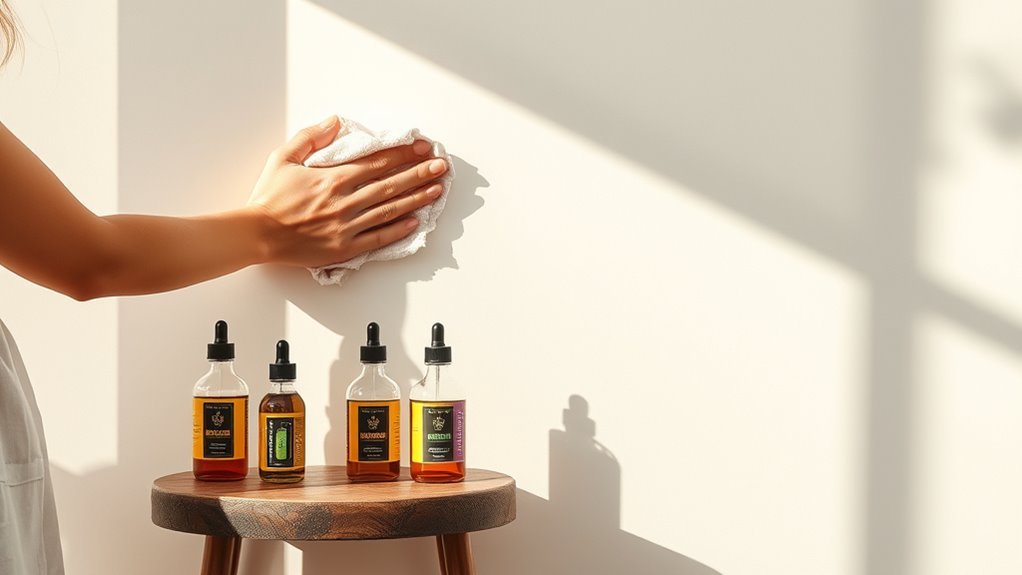
You’ll find that oils like lemon, tea tree, and lavender are great for cleaning walls naturally. Mixing these with water and a bit of vinegar creates simple DIY solutions you can make at home. Just remember to test your mixture on a small spot first and use gloves to keep things safe.
Popular Essential Oils
Essential oils like lemon, tea tree, and lavender are favorites for wall cleaning because they combine natural antibacterial properties with fresh scents. You’ll appreciate tea tree oil for its strong antimicrobial effects, making it ideal to tackle germs quietly and effectively. Lavender properties go beyond its calming aroma; it also offers gentle antiseptic benefits, perfect for maintaining clean walls without harsh chemicals. Lemon oil cuts grease and grime while leaving your space smelling crisp and uplifting. Using these oils gives you freedom from synthetic cleaners and lets you maintain a fresh, healthy environment. When you choose essential oils, you’re embracing a natural, effective way to keep your walls spotless and vibrant without compromising your values or your home’s atmosphere.
DIY Cleaning Recipes
Creating your own cleaning solutions with essential oils is simpler than you might think. By choosing natural alternatives, you not only protect your walls but also embrace eco friendly solutions that align with your desire for freedom from harsh chemicals. Here are some easy DIY recipes to get you started:
- Mix 1 cup water, 1/2 cup white vinegar, and 10 drops lemon essential oil for a fresh, effective cleaner.
- Combine 2 cups warm water, 1 tablespoon baking soda, and 15 drops tea tree oil to tackle tough stains.
- Blend 1 cup water, 1/4 cup castile soap, and 10 drops lavender oil for a gentle, soothing wash.
- Stir 1 cup water with 1/4 cup rubbing alcohol and 10 drops eucalyptus oil to disinfect and refresh walls.
These blends give you control and freedom to clean naturally.
Application Tips and Safety
Although natural oils offer powerful cleaning benefits, it’s important to apply them correctly to avoid damage or irritation. When using essential oil cleaning solutions, always test a small, hidden area first. Choose gentle application methods like a soft cloth or sponge to prevent wall damage. Avoid soaking surfaces, as excess moisture can cause peeling or staining. Remember, some oils can be potent—wear gloves if you have sensitive skin and keep the room well-ventilated to reduce inhalation risks. Store your solutions safely, out of children’s reach. Following these safety precautions not only preserves your walls but also protects your health, giving you the freedom to enjoy a clean, fresh space without worry. Simple care in application goes a long way toward effective and safe wall cleaning.
Techniques for Applying Essential Oil Cleaners to Walls
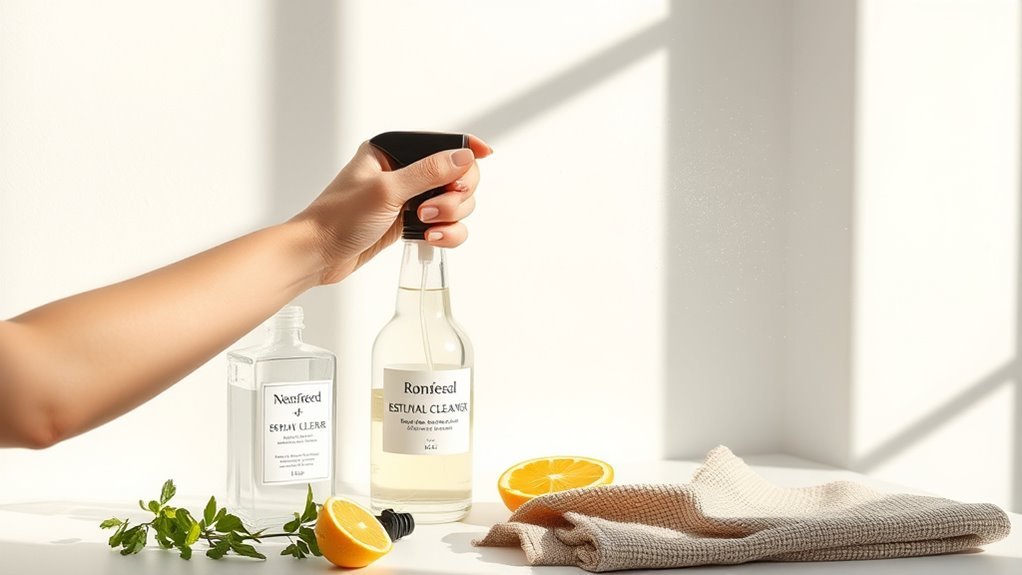
When applying oil-based cleaners to your walls, it’s important to use the right tools and methods to avoid streaks or damage. You want your walls refreshed, not stressed. Start with these techniques for a smooth clean:
- Use spray techniques to evenly mist the essential oil solution, controlling the amount applied without soaking the wall.
- Apply cloth methods with a soft, lint-free cloth to gently wipe the surface, enhancing absorption and preventing streaks.
- Work in small sections, moving from top to bottom to catch drips before they dry.
- Always test a small, hidden area first to verify your cleaner won’t harm the paint or wallpaper.
Removing Stubborn Stains With Essential Oils
Once you’ve mastered the right way to apply oil-based cleaners, tackling tougher stains becomes much easier. Different stain types—like grease, ink, or food spills—respond well to specific essential oils. For instance, lemon or tea tree oil works wonders on grease, while lavender oil can help lift ink marks. Your cleaning methods should involve diluting essential oils with water or a gentle carrier to avoid damaging your walls. Apply the mixture directly to the stain, let it sit briefly, then gently scrub with a soft cloth. This approach not only breaks down stubborn stains but also leaves your walls subtly fresh. By understanding which oils suit which stain types and adjusting your cleaning methods accordingly, you gain the freedom to maintain spotless walls naturally and effectively.
Maintaining Freshness and Cleanliness Between Deep Cleanings
To keep your walls looking fresh between deep cleanings, you’ll want to incorporate essential oils into your routine in simple, consistent ways. These freshness tips will help you maintain cleanliness without feeling tied down by complicated chores. Try these easy cleanliness routines with essential oils:
- Mix a few drops of lavender or eucalyptus oil into water in a spray bottle and lightly mist your walls weekly.
- Use a microfiber cloth dampened with water and a drop of tea tree oil for quick spot cleaning.
- Place cotton balls soaked in lemon oil near vents or corners to keep the air fresh.
- Diffuse your favorite essential oil blend regularly to prevent stale smells from settling.
With these straightforward steps, you’ll enjoy clean, vibrant walls effortlessly, giving you freedom from constant scrubbing.
Frequently Asked Questions
Are Essential Oils Safe for Painted Walls?
You might wonder if essential oils are safe for your painted walls. Generally, they can be, but it depends on your wall finishes. Some oils might react with certain paints or finishes, causing damage or discoloration. To keep your freedom of choice without worry, always test a small, hidden spot first. That way, you’ll know your walls stay protected while enjoying the natural benefits essential oils offer.
Can Essential Oils Prevent Mold Growth on Walls?
Think of essential oil blends as nature’s sentinels, standing guard against mold’s creeping invasion. You’ll find that some oils, like tea tree and eucalyptus, have antifungal powers that aid mold prevention on walls. While they’re not miracle workers, using these blends can create an inhospitable environment for mold, giving you more freedom to enjoy a fresher, cleaner space. Just remember to test first and blend wisely for the best results.
How Often Should I Clean Walls With Essential Oils?
When it comes to cleaning frequency, you don’t need to scrub your walls constantly. For effective wall maintenance, aim to clean them every 1 to 3 months, depending on how much dirt or grime builds up. If you love that fresh, natural vibe, using essential oils can add a pleasant scent while keeping things fresh. Just trust your instincts and adjust the routine to fit your lifestyle and freedom to enjoy a clean space.
Do Essential Oils Affect Wall Paint Durability?
You might wonder if essential oils mess with paint longevity, right? The truth is, essential oil interaction with wall paint is usually minimal if you dilute oils properly. Using undiluted oils frequently could potentially degrade paint over time, but when mixed with water or cleaners, they’re generally safe. So, if you want your walls to last and still enjoy that fresh scent, just don’t go overboard with pure oils!
Can Essential Oils Be Used on Wallpaper?
You can use essential oil blends on wallpaper, but you’ve got to be careful with the wallpaper types. Vinyl or washable wallpapers handle essential oils better than delicate or fabric-based ones, which might stain or weaken with oils. Always test a small, hidden area first to make sure your freedom to freshen up your space doesn’t come with unwanted damage. This way, you enjoy natural scents without restrictions or regrets.
